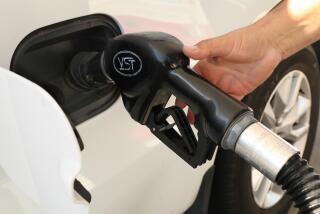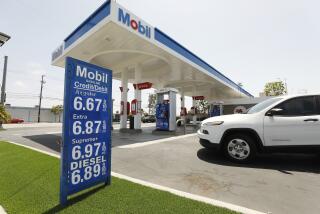Before Taking a Motor Trip, Check Your Cash-Efficiency
- Share via
Yes, the price of gas has gone through the roof (by American standards), but you and your family have already committed to taking a car vacation this summer. How can you make up the money that the recent gas price boosts are likely to cost you?
Here are several ideas, drawn from my own experience and from sources including the Automobile Club of Southern California and the Automotive Trade Organizations of California (also known as Auto-CA), a group that includes more than 2,500 gas retail outlets and auto repair shops statewide.
* When you make that pre-trip inspection of your car don’t just check the tread of your tires and move on to other parts of the car. Make sure those tires are inflated to levels recommended by the maker. Auto club officials assert that for every pound per square inch your tires fall beneath the maker’s recommendation, you lose 2% of fuel economy. Thus, if your 35-psi tires are at 30 psi--which can easily happen--you’re using up gas 10% faster than you otherwise would be. If you have a 10-gallon tank, that would amount to one gallon wasted from every full tank.
* More Americans are driving sport utility vehicles with greater storage space than compact cars have, and many travelers may be unconsciously bringing along more than they need on their trips. Remember that no matter how much room you have in back, you’ll still add to your gas bill with every pound you add to the vehicle’s overall weight.
* When you start your car, remember to let it idle 15-20 seconds, not to save gas, but to let oil circulate so that the engine can run more smoothly when you put the car into gear. However, once you’ve begun a journey, and you find yourself idling at a rest stop or view point or gas station, don’t idle for more than about a minute. Instead, turn the engine off to stop burning gas. Just because the car isn’t moving doesn’t mean that gas isn’t being used.
* On the road, try to set a consistent pace, avoiding rapid surges and decelerations for reasons other than safety. Sudden stomps on the accelerator burn gas rapidly and inefficiently.
* If your vehicle’s owner’s manual says it should use gas with an 87 octane rating, then don’t splurge on gas rated at 89 or 92. Auto club officials say the benefits to your car will be minimal, but the added gas bill is likely to be substantial. At many stations, the price gap between 87 octane and 92 octane gas is as much as 20 cents per gallon.
* Obviously, self-service pumps are cheaper than full-service pumps. But you can end up costing yourself money, and reducing your own safety, if you use self-service without pursuing the usual program of preventive maintenance checks. Remember to check and change your oil at recommended intervals, and to monitor other fluid levels, filters and your tires’ air pressure, as well.
* If you belong to AAA (39 million Americans do), check for membership discounts at hotel and motels. The membership discount is often 10%, sometimes as much as 25%, and is available at many high-end hotels that travelers don’t necessarily associate with roadside lodging. Remember, too, that if you have a discount hotel card, such as those sold by Entertainment Publications, you may be be able to get an even deeper hotel discount. Also keep in mind that at many hotels that serve business travelers--particularly those in city centers--rates fall on weekends. Finally, if you arrive at a hotel in the evening without reservations, and you can see that a place is far from full, haggle. Many front-desk workers do have the authority to cut prices to fill rooms that would otherwise go empty.
* Keep in mind that gas tends to be more expensive in the westernmost states than it is anywhere else in the continental U.S. In a May 6 survey by the federal Energy Information Administration, average prices in California, Nevada, Arizona, Oregon and Washington hovered at $1.50 a gallon. In every other region of the continental U.S., average prices ran $1.32 or below. The U.S. average was $1.28--22 cents per gallon below the West Coast average.
* Consider the desert. Hotels in areas such as Palm Springs and greater Phoenix generally slash their rates--sometimes cutting them in half during the hot summer months. If you, your family and your car can withstand the heat, you could more than make up for the heightened cost of driving.
* Wherever you go, think twice before you buy breakfast in a hotel restaurant. The prices are almost always highly inflated. By all means, eat whatever a lodging is providing for free, but if you can search out a nearby coffee shop or similar restaurant, you’re far more likely to avoid those $3.50 glasses of orange juice. At lunchtime, consider picnics. And instead of relying on snack food from gas station and convenience stores, load up on snacks at a grocery store; you may not only spend less, but also find more healthful items.
Lastly, remember that old American institution, the early-bird dinner. It’s waiting for you at many roadside eateries, if you don’t mind beginning your dinner before 6 p.m.
Reynolds travels anonymously at the newspaper’s expense, accepting no special discounts or subsidized trips. To reach him, write Travel Insider, Los Angeles Times, Times Mirror Square, Los Angeles 90053; telephone (213) 237-7845.







